Gas mileage discussion + thread collection
- Sneaks
- Posts: 1652
- Joined: Thu Apr 26, 2007 8:32 am
Gas mileage discussion + thread collection
Collection of gas mileage related threads. Let me know if you want anything added. Feel free to discuss ways to improve MPG here as well.
General:
Gas mileage vs displacement
General Discussion
Fixing bad mileage
Fixing bad mileage - pt2
Type 1:
General Mileage discussion
More mileage ideas
Optimizing Mileage
33MPG with stock 1500
HotVW Mileage build discussion
Mileage motor build
Another Mileage motor build
Heads:
More Head talk
Cam selection
Deck Height talk
Better mileage from 2110
Type 4:
9550 mileage
Tips for improving mileage
More MPG
General:
Gas mileage vs displacement
General Discussion
Fixing bad mileage
Fixing bad mileage - pt2
Type 1:
General Mileage discussion
More mileage ideas
Optimizing Mileage
33MPG with stock 1500
HotVW Mileage build discussion
Mileage motor build
Another Mileage motor build
Heads:
More Head talk
Cam selection
Deck Height talk
Better mileage from 2110
Type 4:
9550 mileage
Tips for improving mileage
More MPG
- Sneaks
- Posts: 1652
- Joined: Thu Apr 26, 2007 8:32 am
-
dawie
- Posts: 126
- Joined: Sun Jan 20, 2008 1:56 pm
Re: Gas mileage discussion + thread collection
Some data:
At top speed, over 90% of power needed to keep the vehicle moving is used to overcome aerodynamic drag.
Power needed to keep a beetle body moving at constant speed on level wind-free road:
At 62 mph/ 100 kmh: 24 bhp ( 53 beetle 1130cc / 5,8:1 comp "30 sae hp"/24bhp/19kw)
At 72 mph/ 116 kmh: 34 bhp ( 63 beetle 1192cc / 7.0:1 comp "40 sae hp"/34bhp)
At 81 mph/ 130 kmh: + - 48/ 50 bhp ( beetle 1600 single / dual port)
Above data from various magazines that did speedo corrected tests using 5th wheel calibrated instruments.
VW's are geared so that top speed roughly (but not always), occurs near max power in 4th gear.
Karmann Ghia body did 5mph faster (77mph/ 116kmh) with same 1192cc 34bhp engine as beetle.
(Tested by same magazine on same level road, average of speed both directions). Ghia 1192cc had same gearing as beetle, maybe slightly taller gearing (to take advantage of it's aerodynamics), would make it 1 or 2 mph faster).
In fact, if so it would then have around the same top speed as a 1500 beetle, while only using 34bhp in stead of the beetle's 44bhp, (but obviously take much longer to reach that speed).
Type 3 body:
Intersting comparison is early squareback with original 1500 single carb (32PHN sidedraft 23.5mm venturi) 45bhp.
Same gearing as 44hp 1500 beetle. Tested by same magazine, same equipment, same place.
Accelerating to 50mph, the beetle was faster at 13.3 seconds versus the heavier squareback's 14.9 seconds. Beetle reached 70mph in 37.5 seconds. By that time, the type 3, even in squareback form, have already made up lost time and passed it 2 seconds earlier at 35.4 seconds.
Some calculated that notch and fastback had less drag than squareback, but, strangely, i could not find any data that supported a major difference. Think that a small flat spoiler (starting below the fastback's rear window,continuing level. Untill the rearmost part of car while slowly tapering inwards from the sides. Stopping abruptly there, Kamm effect). Think something similar at the rear would improve the Karmann Ghia as well.
What hurts the beetle and many other cars, is the rounded rear, which causes flow separation/turbulence. Compare a round sphere with another sphere cut in half. Facing the wind with it's rounded side, the "cut off" sphere (sharp edges facing rearwards) has much reduced drag compared to the rounded one. This is called the "Kamm effect".
Power needed to overcome aerodynamic drag rises exponentially as speed increases, so for a small increase in speed, a large increase in power is needed.
A bay or split bus roughly needs 50% more power to keep it moving at same speed as compared to a beetle.
Coefficient of drag:
Various figures related to aircooled VW's were quoted over the years. Calibration differences occurred between various wind tunnels and for the same wind tunnel over different years. Especially around the 60's and earlier.
Beetle: cd 0.46 to 0.48 mostly quoted, sometimes up to 0.49, and around the 1930's they quoted cd 0.39 (which was probably too optimistic at the time).
My guess probably 0.48 for 1958- onwards flat screen beetles. Maybe 0.46 for earlier versions which had the much smaller windscreen and more gentle curve at critical area near the top of windscreen.
Super beetle/1303 had cd 0.44 mentioned.
Baywindow and split bus- around cd 0.42 Obviously it has about 50% more frontal area, so total drag is more. (Westfalia bay was worse.) Around 0.39 was once mentioned for early split. (Probaly the pre-1954 barndoor version without the "peak" over the windshield). Vanagon: cd 0.45, and cd 0.44 with front spoiler. Vanagon is wider, so frontal area is more than bay.
Interesting study from the 1930's was the "Pillbug" by professor Schlor. Built before the beetle chassis was available, it used the chassis from a Mercedes 170h rear- engined car. It was a 7-seater and cd was somewhere around 0.15.
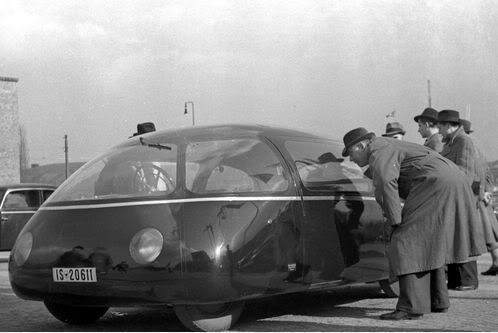
Obviously, below 30mph aerodynamics is of little importance. Then reducing weight (acceleration/deceleration) in city driving conditions is important
At top speed, over 90% of power needed to keep the vehicle moving is used to overcome aerodynamic drag.
Power needed to keep a beetle body moving at constant speed on level wind-free road:
At 62 mph/ 100 kmh: 24 bhp ( 53 beetle 1130cc / 5,8:1 comp "30 sae hp"/24bhp/19kw)
At 72 mph/ 116 kmh: 34 bhp ( 63 beetle 1192cc / 7.0:1 comp "40 sae hp"/34bhp)
At 81 mph/ 130 kmh: + - 48/ 50 bhp ( beetle 1600 single / dual port)
Above data from various magazines that did speedo corrected tests using 5th wheel calibrated instruments.
VW's are geared so that top speed roughly (but not always), occurs near max power in 4th gear.
Karmann Ghia body did 5mph faster (77mph/ 116kmh) with same 1192cc 34bhp engine as beetle.
(Tested by same magazine on same level road, average of speed both directions). Ghia 1192cc had same gearing as beetle, maybe slightly taller gearing (to take advantage of it's aerodynamics), would make it 1 or 2 mph faster).
In fact, if so it would then have around the same top speed as a 1500 beetle, while only using 34bhp in stead of the beetle's 44bhp, (but obviously take much longer to reach that speed).
Type 3 body:
Intersting comparison is early squareback with original 1500 single carb (32PHN sidedraft 23.5mm venturi) 45bhp.
Same gearing as 44hp 1500 beetle. Tested by same magazine, same equipment, same place.
Accelerating to 50mph, the beetle was faster at 13.3 seconds versus the heavier squareback's 14.9 seconds. Beetle reached 70mph in 37.5 seconds. By that time, the type 3, even in squareback form, have already made up lost time and passed it 2 seconds earlier at 35.4 seconds.
Some calculated that notch and fastback had less drag than squareback, but, strangely, i could not find any data that supported a major difference. Think that a small flat spoiler (starting below the fastback's rear window,continuing level. Untill the rearmost part of car while slowly tapering inwards from the sides. Stopping abruptly there, Kamm effect). Think something similar at the rear would improve the Karmann Ghia as well.
What hurts the beetle and many other cars, is the rounded rear, which causes flow separation/turbulence. Compare a round sphere with another sphere cut in half. Facing the wind with it's rounded side, the "cut off" sphere (sharp edges facing rearwards) has much reduced drag compared to the rounded one. This is called the "Kamm effect".
Power needed to overcome aerodynamic drag rises exponentially as speed increases, so for a small increase in speed, a large increase in power is needed.
A bay or split bus roughly needs 50% more power to keep it moving at same speed as compared to a beetle.
Coefficient of drag:
Various figures related to aircooled VW's were quoted over the years. Calibration differences occurred between various wind tunnels and for the same wind tunnel over different years. Especially around the 60's and earlier.
Beetle: cd 0.46 to 0.48 mostly quoted, sometimes up to 0.49, and around the 1930's they quoted cd 0.39 (which was probably too optimistic at the time).
My guess probably 0.48 for 1958- onwards flat screen beetles. Maybe 0.46 for earlier versions which had the much smaller windscreen and more gentle curve at critical area near the top of windscreen.
Super beetle/1303 had cd 0.44 mentioned.
Baywindow and split bus- around cd 0.42 Obviously it has about 50% more frontal area, so total drag is more. (Westfalia bay was worse.) Around 0.39 was once mentioned for early split. (Probaly the pre-1954 barndoor version without the "peak" over the windshield). Vanagon: cd 0.45, and cd 0.44 with front spoiler. Vanagon is wider, so frontal area is more than bay.
Interesting study from the 1930's was the "Pillbug" by professor Schlor. Built before the beetle chassis was available, it used the chassis from a Mercedes 170h rear- engined car. It was a 7-seater and cd was somewhere around 0.15.

Obviously, below 30mph aerodynamics is of little importance. Then reducing weight (acceleration/deceleration) in city driving conditions is important
-
dawie
- Posts: 126
- Joined: Sun Jan 20, 2008 1:56 pm
Re: Gas mileage discussion + thread collection
Consumption at 60mph:
Beetle 1200: 31.7 m/(US)g. 38.1m/(IMP)g. 7.4l/100km (Car magazine 1963).
Beetle 1500: 30.1 m/(US)g. 36.3m/(IMP)g 7.8l/100km. (Car July 1968)
Beetle 1300 dual port: 31.1m/(US)g 37.4m/(IMP)g 7.55l/100km (Car Mar 1971)
Beetle 1600 dual port: 26.3m/(US)g 31.6m/(IMP)g 8.94l/100km (Car Jun 1971)
This just as a baseline for comparison. All 4 engines delivering the same 24 hp it requires to keep a beetle body moving at a steady 60mph.
Note that the 1200 and 1500 probably had same jetting in US as "rest of the world" models. (1200 probably had 122.5 main jet, and 1500 probably 120 main).
The 1300 dual port was not available in the USA, but info still useful.
Beetle 1600 was jetted leaner for use in the US.
Jetting of 1600 dual port is interesting.
Initially the first dual port engines (outside the US) were jetted extremely rich at lower rpm's. (Remember 71 was "pre-fuel crisis"). This was changed for the 72 model year, (possibly even sooner).
34PICT for 71 1600 beetle had 26 vent, 145 main, air correction 130
Bus had 140 main and 120 air.
For 72 Beetle this changed to 130 main and a low 60 air correction. (Think US had 127 main and 75 or 80 airs?
Bus changed to 125 main and 60 air.
Beetle 1200: 31.7 m/(US)g. 38.1m/(IMP)g. 7.4l/100km (Car magazine 1963).
Beetle 1500: 30.1 m/(US)g. 36.3m/(IMP)g 7.8l/100km. (Car July 1968)
Beetle 1300 dual port: 31.1m/(US)g 37.4m/(IMP)g 7.55l/100km (Car Mar 1971)
Beetle 1600 dual port: 26.3m/(US)g 31.6m/(IMP)g 8.94l/100km (Car Jun 1971)
This just as a baseline for comparison. All 4 engines delivering the same 24 hp it requires to keep a beetle body moving at a steady 60mph.
Note that the 1200 and 1500 probably had same jetting in US as "rest of the world" models. (1200 probably had 122.5 main jet, and 1500 probably 120 main).
The 1300 dual port was not available in the USA, but info still useful.
Beetle 1600 was jetted leaner for use in the US.
Jetting of 1600 dual port is interesting.
Initially the first dual port engines (outside the US) were jetted extremely rich at lower rpm's. (Remember 71 was "pre-fuel crisis"). This was changed for the 72 model year, (possibly even sooner).
34PICT for 71 1600 beetle had 26 vent, 145 main, air correction 130
Bus had 140 main and 120 air.
For 72 Beetle this changed to 130 main and a low 60 air correction. (Think US had 127 main and 75 or 80 airs?
Bus changed to 125 main and 60 air.
-
dawie
- Posts: 126
- Joined: Sun Jan 20, 2008 1:56 pm
Re: Gas mileage discussion + thread collection
BSFC maps.
This is a typical brake specific fuel consumption map.
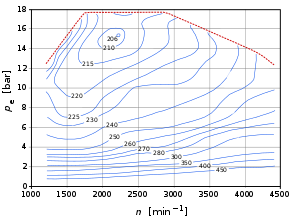
Reads like a topographical map. Usually (but not always), lowest consumption is reached just below max torque or around 70% load, when pumping losses are low. But before full load enrichment is enabled at full load. Obviously a bit different in carbed applications.
Modifying an engine (either for performance or efficiency reasons), changes the map.
The map differs between various engines, depending on at which rpm's and load their mixture ratios and spark advance changes, and other variables like compression ratio, cam timing, etc.
This is a typical brake specific fuel consumption map.

Reads like a topographical map. Usually (but not always), lowest consumption is reached just below max torque or around 70% load, when pumping losses are low. But before full load enrichment is enabled at full load. Obviously a bit different in carbed applications.
Modifying an engine (either for performance or efficiency reasons), changes the map.
The map differs between various engines, depending on at which rpm's and load their mixture ratios and spark advance changes, and other variables like compression ratio, cam timing, etc.
-
dawie
- Posts: 126
- Joined: Sun Jan 20, 2008 1:56 pm
Re: Gas mileage discussion + thread collection
The Jon Karcey project: (as published in VW Classics):
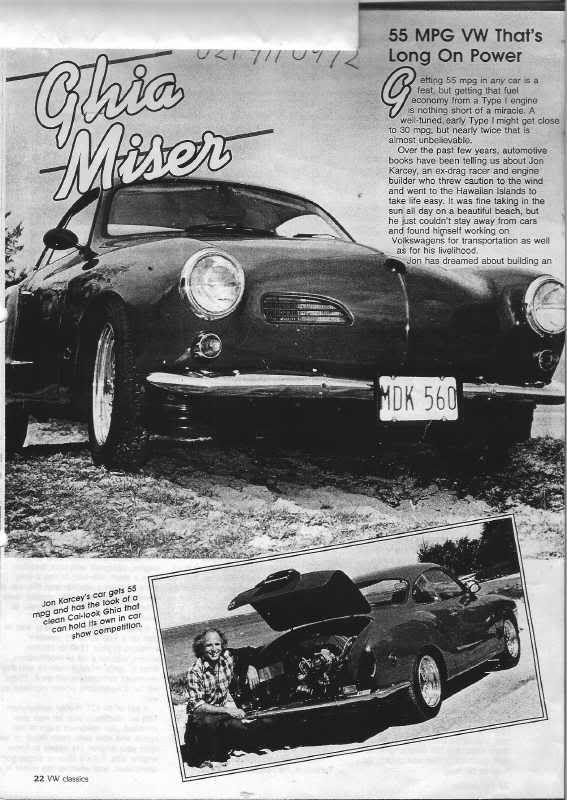
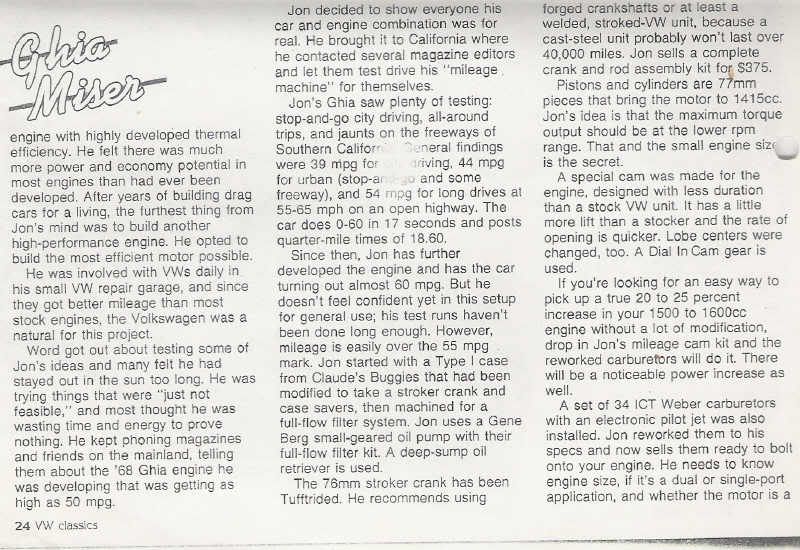
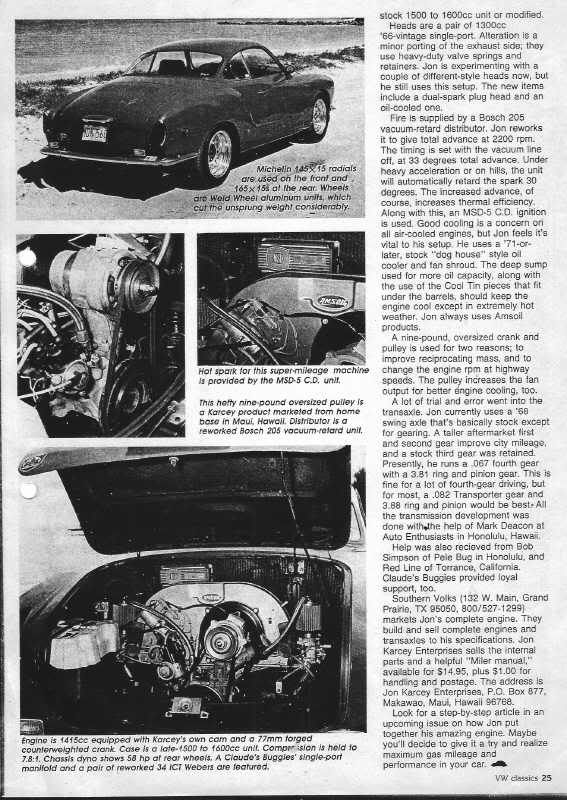



- Sneaks
- Posts: 1652
- Joined: Thu Apr 26, 2007 8:32 am
Re: Gas mileage discussion + thread collection
[whisper]If you build it...they will come[/whisper]
- supaninja
- Posts: 1658
- Joined: Tue Sep 14, 2010 12:48 pm
Re: Gas mileage discussion + thread collection
I want to start this off by stating I wish I had more hard quantitative data, so I can state hard numbers, but this is the best I got right now, and things are always changing on my setup.
Miles Per Gallon is a measurement of the efficiency of a vehicle as a whole, much like a quarter mile time is measurement of speed of a vehicle as a whole. It is the end result of all parts of the vehicle including the driver. That being said, the driver is a very important part of the equation, maybe even the most important part.
Your vehicles weight and drag are important, but it's not the end all be all for efficiency. Same with tire contact patch size and gearing.
So my car isn't a built hyper-miler, it is just a 65 notch, rolling on 17's and 205/215's, with stock gearing. I did all the appropriate maintenance, repacked the front bearings, synthetic gear oil to the proper level, rear brakes are adjusted tight like they are supposed to be, and I just set my front toe-in to 1/16". So far nothing unusual, actually on paper it looks like a horrible setup. The magic is in the motor/EFI/ign combo/tune, if you can burn the fuel as efficiently as the motor can safely do it and you drive it as smoothly and efficiently as possible then you will see a noticeable improvement in mileage, period.
Motor- I have a 2L bus motor, stock internals all balanced. The cam is one jake's modified 494 web cams (John's description on AC.net is "it has a nasty midrange"), and 1.7L heads bored out. Pretty standard so far, I bumped the compression to 8.5, and my deck height is tight, .028". The tight deck height gives me two things, compression and more quench. Both of those things are going to improve the efficiency of these motors. ACVW people are scared of running compression, I think its just an unintended consequence of years and years of using inferior fuel and ignition systems. The year is 2012, you can now precisely control fuel and spark accurately enough to run good compression with today's fuel. Oh btw I'm a huge fan of ethanol and have had amazing results powerwise on a different platform, there is lots and lots of false claims and ignorance floating around cyber space on the subject, but ask any of the top tuners what they think about the stuff.
Injection- This is where you start to separate the boys (carbs) from the men (EFI). I fancy ITB setups on this motor, inlines I like plenums better. Either or works for increasing mpgs but ITBs are more efficient and your not sacrificing top end. There are still lots of factors and I'm not going to detail on most of them but you need to consider: inj angle, distance of the injector from the valves, intake length, atomization, and most importantly the injector. they all have their part to play in the big picture but the most important single aspect is the injector being used. That determines the atomization and amount of control your management will have of fuel. For a clean idle the injectors need to spray the back of the intake valves, but for mpgs the higher up the intake the better. The more time the fuel is traveling through the intake the more time it gets to be atomized, of course within reason (this is for ITB style).
Spark- if your planning on trying to max out mpg's while using a 009 or any centrifugal dizzy you need to do some research on your own because you will be better off just shooting yourself in the foot. Spark advance in cruise is the secret and digital ign is the easiest and most controlled means to achieve it. The timing the motor needs at WOT is way different then what it needs when your cruising down the freeway at 70 mph. For mpg purposes you want to run as much timing as the motor will take while in cruise. This is where you need to get some dyno time to fine tune it. There is a point where you can add timing and you won't gain any more power (more power means less throttle). Another big bonus to running a digital ign is you can use powerful coils and run long dwell. Hotter, longer spark means more efficent fuel burn which means more powa and efficiency. The last bonus, which I like a lot, is a digital ign setup also deletes the mechanical failure prone distributor ignition system, reliable is good.
Tune- this is what ties everything together, if everything is up to snuff you can now dial everything in to exactly what your particular motor wants get the most out of your engine to max out the MPG's. Everyday is not the same, some days are hotter, some are colder, humidity, barometric pressure, elevation...they all affect the efficiency of the motor and your mpgs. I'm not even going to get into rejetting carbs since they don't take into account any of that stuff and this topic is about mpgs. I like running lean at cruise with lots of timing and as much dwell as my coils can reliably deliver. The number 14.7, stoich, has been pounded into everyones head, forget about that is just for emissions. We are not chasing the cleanest burning engine here, we are after the most efficient motor. My motor likes 15.0-15.5 AFR's, your motor might like 16.0 or 14.8, every motor is different. My motor also likes 45 degrees of advance while cruising, yours might only like 38. I talked to my tuner buddy about this, he asked for all the specs on my motor and told me to try 50 degrees. The motor is not at high load so it is perfectly safe to run some timing. Caution, you do want to monitor your head temps before you start throwing lots of timing at it.
With my short intakes, 38mm TBs, and small injectors I got 35-40 mpg's, keep in mind this is just a regular VW the car is not built up for hyper-miling, and I got a 2L. I recently changed the TB's to 40, different mani's, bigger injectors, and bumped the fuel pressure up. A little more tuning should yield 40-45 mpgs, we will see.
Miles Per Gallon is a measurement of the efficiency of a vehicle as a whole, much like a quarter mile time is measurement of speed of a vehicle as a whole. It is the end result of all parts of the vehicle including the driver. That being said, the driver is a very important part of the equation, maybe even the most important part.
Your vehicles weight and drag are important, but it's not the end all be all for efficiency. Same with tire contact patch size and gearing.
So my car isn't a built hyper-miler, it is just a 65 notch, rolling on 17's and 205/215's, with stock gearing. I did all the appropriate maintenance, repacked the front bearings, synthetic gear oil to the proper level, rear brakes are adjusted tight like they are supposed to be, and I just set my front toe-in to 1/16". So far nothing unusual, actually on paper it looks like a horrible setup. The magic is in the motor/EFI/ign combo/tune, if you can burn the fuel as efficiently as the motor can safely do it and you drive it as smoothly and efficiently as possible then you will see a noticeable improvement in mileage, period.
Motor- I have a 2L bus motor, stock internals all balanced. The cam is one jake's modified 494 web cams (John's description on AC.net is "it has a nasty midrange"), and 1.7L heads bored out. Pretty standard so far, I bumped the compression to 8.5, and my deck height is tight, .028". The tight deck height gives me two things, compression and more quench. Both of those things are going to improve the efficiency of these motors. ACVW people are scared of running compression, I think its just an unintended consequence of years and years of using inferior fuel and ignition systems. The year is 2012, you can now precisely control fuel and spark accurately enough to run good compression with today's fuel. Oh btw I'm a huge fan of ethanol and have had amazing results powerwise on a different platform, there is lots and lots of false claims and ignorance floating around cyber space on the subject, but ask any of the top tuners what they think about the stuff.
Injection- This is where you start to separate the boys (carbs) from the men (EFI). I fancy ITB setups on this motor, inlines I like plenums better. Either or works for increasing mpgs but ITBs are more efficient and your not sacrificing top end. There are still lots of factors and I'm not going to detail on most of them but you need to consider: inj angle, distance of the injector from the valves, intake length, atomization, and most importantly the injector. they all have their part to play in the big picture but the most important single aspect is the injector being used. That determines the atomization and amount of control your management will have of fuel. For a clean idle the injectors need to spray the back of the intake valves, but for mpgs the higher up the intake the better. The more time the fuel is traveling through the intake the more time it gets to be atomized, of course within reason (this is for ITB style).
Spark- if your planning on trying to max out mpg's while using a 009 or any centrifugal dizzy you need to do some research on your own because you will be better off just shooting yourself in the foot. Spark advance in cruise is the secret and digital ign is the easiest and most controlled means to achieve it. The timing the motor needs at WOT is way different then what it needs when your cruising down the freeway at 70 mph. For mpg purposes you want to run as much timing as the motor will take while in cruise. This is where you need to get some dyno time to fine tune it. There is a point where you can add timing and you won't gain any more power (more power means less throttle). Another big bonus to running a digital ign is you can use powerful coils and run long dwell. Hotter, longer spark means more efficent fuel burn which means more powa and efficiency. The last bonus, which I like a lot, is a digital ign setup also deletes the mechanical failure prone distributor ignition system, reliable is good.
Tune- this is what ties everything together, if everything is up to snuff you can now dial everything in to exactly what your particular motor wants get the most out of your engine to max out the MPG's. Everyday is not the same, some days are hotter, some are colder, humidity, barometric pressure, elevation...they all affect the efficiency of the motor and your mpgs. I'm not even going to get into rejetting carbs since they don't take into account any of that stuff and this topic is about mpgs. I like running lean at cruise with lots of timing and as much dwell as my coils can reliably deliver. The number 14.7, stoich, has been pounded into everyones head, forget about that is just for emissions. We are not chasing the cleanest burning engine here, we are after the most efficient motor. My motor likes 15.0-15.5 AFR's, your motor might like 16.0 or 14.8, every motor is different. My motor also likes 45 degrees of advance while cruising, yours might only like 38. I talked to my tuner buddy about this, he asked for all the specs on my motor and told me to try 50 degrees. The motor is not at high load so it is perfectly safe to run some timing. Caution, you do want to monitor your head temps before you start throwing lots of timing at it.
With my short intakes, 38mm TBs, and small injectors I got 35-40 mpg's, keep in mind this is just a regular VW the car is not built up for hyper-miling, and I got a 2L. I recently changed the TB's to 40, different mani's, bigger injectors, and bumped the fuel pressure up. A little more tuning should yield 40-45 mpgs, we will see.

'65 notch w/ a squirted type 4
http://supaninjanick.wordpress.com/
'68 "Zombie Response Vehicle" Westy
viewtopic.php?f=14&t=140387
-
dawie
- Posts: 126
- Joined: Sun Jan 20, 2008 1:56 pm
Re: Gas mileage discussion + thread collection
That is good mileage, especially as you did not build a dedicated mileage project.
Agree on the 009... Although it's body could be used to accommodate a "cam position" sensor.
When experimenting i found that engine is most knock sensitive around peak egt/ (roughly around stoich afr?)
My idea is: using efi to guarantee that engine never ever run near peak egt. Either 16.5- 17:1 or 11.5-12.5:1 (If pinging occurs, (in addition to timing retard), either richen the mixture (if on rich side) or lean some more (if on the lean side).
If this could be guaranteed, a much higher compression ratio could be used safely. The higher compression should help speed up burning of lean mixture without too much extra advance needed.
Engine would nearly always run in "lean mode". At full throttle, (overtaking acceleration, etc) afr jumps to rich mode. To prevent hunting between the two modes, (as in a "gap" in power"), halfway we run 2 cylinders in lean mode and the other 2 in rich. In 1/4 or 3/4 position through the power gap, we run 3 cylinders the one ratio and remaining cylinder the other ratio.
Obviously a strong ignition system along with large plug gaps will be needed, ideally using twin plugs.
There is also the triple plug type 4 chamber that i mentioned elsewhere, and welding the chamber for increased squish area.
Agree on the 009... Although it's body could be used to accommodate a "cam position" sensor.
When experimenting i found that engine is most knock sensitive around peak egt/ (roughly around stoich afr?)
My idea is: using efi to guarantee that engine never ever run near peak egt. Either 16.5- 17:1 or 11.5-12.5:1 (If pinging occurs, (in addition to timing retard), either richen the mixture (if on rich side) or lean some more (if on the lean side).
If this could be guaranteed, a much higher compression ratio could be used safely. The higher compression should help speed up burning of lean mixture without too much extra advance needed.
Engine would nearly always run in "lean mode". At full throttle, (overtaking acceleration, etc) afr jumps to rich mode. To prevent hunting between the two modes, (as in a "gap" in power"), halfway we run 2 cylinders in lean mode and the other 2 in rich. In 1/4 or 3/4 position through the power gap, we run 3 cylinders the one ratio and remaining cylinder the other ratio.
Obviously a strong ignition system along with large plug gaps will be needed, ideally using twin plugs.
There is also the triple plug type 4 chamber that i mentioned elsewhere, and welding the chamber for increased squish area.
- Sneaks
- Posts: 1652
- Joined: Thu Apr 26, 2007 8:32 am
Re: Gas mileage discussion + thread collection
Great stuff so far, guys! Hopefully more will jump in. Thanks Doc for making it a sticky!!
I'll jump into a controversial subject for my contribution:
Synthetic lubes.
Forums are full of post that say you can't or shouldn't use synthetics in a VW motor. Removing the ZDDP component (I know it's important but that's been covered quite well right here), people still say it will cause it to overheat (false) and leak more (true).
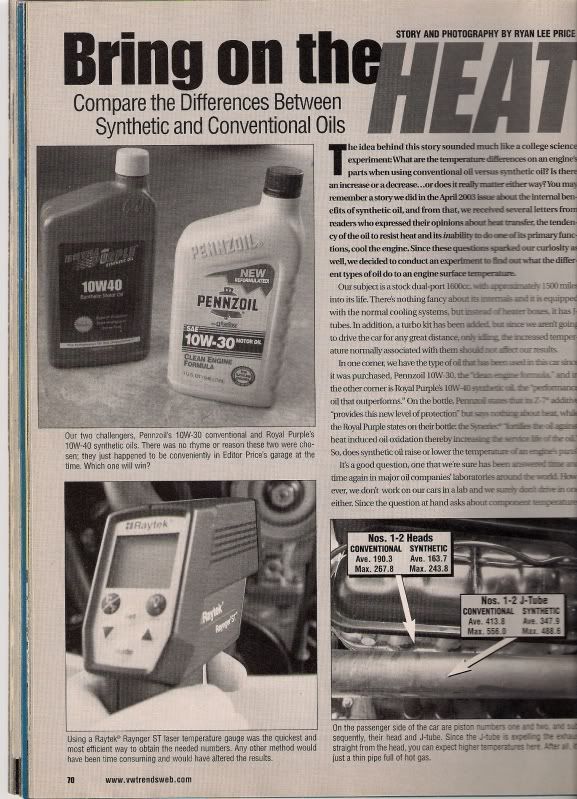
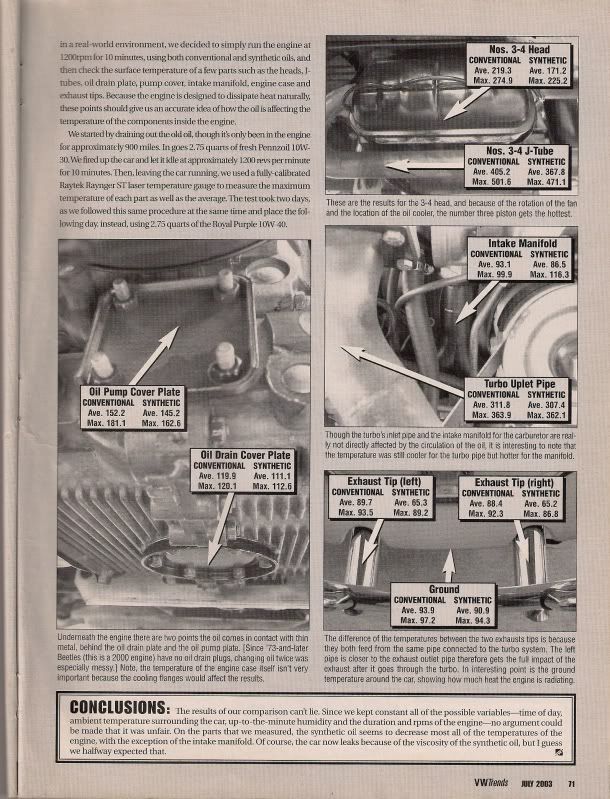
I use synthetics in all my vehicles. Not only does it need to be changed less often but it really does make a difference with performance. For an example, I had a 1998 Dodge RAM 1500 2wd with 318\auto that I bought with 15K on it in 1999. First couple of tanks of gas I was averaging 15mpg, sticker on the windshield was from Pronto and it had dino oil in it. I did an oil change and put in Royal Purple 5W30. I noticed that next tank I went 2 days longer before filling up so I decided to check my mileage again. I averaged it out over 3 tanks to eliminate any variance due to traffic, side trips, etc. I averaged 17.5mph. That's a 15% increase. The oil costs $3 a quart more or $15 more per change but changes went from 3000 miles to 9000 miles so I actually saved money just in buying oil. Impressed by this, I then changed my transmission fluid to ATF+4 synthetic as well as replaced the rear diff lube with 75/90 synthetic, repacked the wheel bearings, changed the PS fluid to synthetic. This netted me an additional .5mpg up to 18mpg for an improvement of 17% total.
YMMV.
I'll jump into a controversial subject for my contribution:
Synthetic lubes.
Forums are full of post that say you can't or shouldn't use synthetics in a VW motor. Removing the ZDDP component (I know it's important but that's been covered quite well right here), people still say it will cause it to overheat (false) and leak more (true).


I use synthetics in all my vehicles. Not only does it need to be changed less often but it really does make a difference with performance. For an example, I had a 1998 Dodge RAM 1500 2wd with 318\auto that I bought with 15K on it in 1999. First couple of tanks of gas I was averaging 15mpg, sticker on the windshield was from Pronto and it had dino oil in it. I did an oil change and put in Royal Purple 5W30. I noticed that next tank I went 2 days longer before filling up so I decided to check my mileage again. I averaged it out over 3 tanks to eliminate any variance due to traffic, side trips, etc. I averaged 17.5mph. That's a 15% increase. The oil costs $3 a quart more or $15 more per change but changes went from 3000 miles to 9000 miles so I actually saved money just in buying oil. Impressed by this, I then changed my transmission fluid to ATF+4 synthetic as well as replaced the rear diff lube with 75/90 synthetic, repacked the wheel bearings, changed the PS fluid to synthetic. This netted me an additional .5mpg up to 18mpg for an improvement of 17% total.
YMMV.
-
miniman82
- Posts: 3944
- Joined: Sun Apr 27, 2008 3:36 pm
- supaninja
- Posts: 1658
- Joined: Tue Sep 14, 2010 12:48 pm
Re: Gas mileage discussion + thread collection
Sneaks- I realized after I posted my dissertation that I forgot to mention I have only used 10W30 syn oil (usually VR1 racing oil). I also neglected to mention that I have a crankcase evacuation setup for the engine breather. For those who don't know, a crankcase evac uses the exhaust to create a vacuum inside the crankcase. The don't have pressure on the backside and the rings seal up better, both are great benefits for making a more efficient engine.

'65 notch w/ a squirted type 4
http://supaninjanick.wordpress.com/
'68 "Zombie Response Vehicle" Westy
viewtopic.php?f=14&t=140387
-
damo99
- Posts: 208
- Joined: Tue Jan 01, 2008 9:31 pm
Re: Gas mileage discussion + thread collection
i used to run a vacupan(as we call them) (crankcase evacuation setup)supaninja wrote:Sneaks- I also neglected to mention that I have a crankcase evacuation setup for the engine breather. For those who don't know, a crankcase evac uses the exhaust to create a vacuum inside the crankcase. .
when i did it, it used to blow blue smoke out the exhaust due to
a mist of oil running through it.
do you have that problem also.
- Piledriver
- Moderator
- Posts: 22520
- Joined: Sat Feb 16, 2002 12:01 am
Re: Gas mileage discussion + thread collection
You can overdo case vacuum, and you need a good air/oil separator, and an installation location that keeps it heated, or the separator will load up with vaseline.
It's also a feature to have a vacuum break that feeds into the 3/4 side rocker box, as that small amount of airflow will keep the oil from filling up the rocker box at cruise RPMS.
(most) T4s have breather chimneys, and T1s have alt stands, both of which have room to stuff a couple woven SS pot scrubbers into... Work wonders for separating the oil from the airstream, and it keeps them at block temps to prevent vaseline buildup.
It's also a feature to have a vacuum break that feeds into the 3/4 side rocker box, as that small amount of airflow will keep the oil from filling up the rocker box at cruise RPMS.
(most) T4s have breather chimneys, and T1s have alt stands, both of which have room to stuff a couple woven SS pot scrubbers into... Work wonders for separating the oil from the airstream, and it keeps them at block temps to prevent vaseline buildup.
Addendum to Newtons first law:
zero vehicles on jackstands, square gets a fresh 090 and 1911, cabby gets a blower.
EZ3.6 Vanagon after that.(mounted, needs everything finished) then Creamsicle.
zero vehicles on jackstands, square gets a fresh 090 and 1911, cabby gets a blower.
EZ3.6 Vanagon after that.(mounted, needs everything finished) then Creamsicle.
-
dawie
- Posts: 126
- Joined: Sun Jan 20, 2008 1:56 pm
Re: Gas mileage discussion + thread collection
Any thoughts regarding sequential injection timing, specifically related to mileage?
Some good reading here: http://www.shoptalkforums.com/viewtopic ... ion+timing
Start of injection:
a) when inlet valve opens, or
b) the moment after inlet valve closes?
In above-mentioned link see Piledriver mentioned that b) is how it's done in oem applications, so maybe that's best?
Would pre-heating of intake air during lighter load conditions be of some help, (As done in some carbed applications).
How about 2 injections per engine cycle. One after inl valve closed, and another one 360 deg later.
And then there's CIS/ Kjet-e Spray still continuous during lighter load conditions. Possibly good for mileage specific applications, where the slight restriction caused by metering flap is not as detrimental as in racing?
Some good reading here: http://www.shoptalkforums.com/viewtopic ... ion+timing
Start of injection:
a) when inlet valve opens, or
b) the moment after inlet valve closes?
In above-mentioned link see Piledriver mentioned that b) is how it's done in oem applications, so maybe that's best?
Would pre-heating of intake air during lighter load conditions be of some help, (As done in some carbed applications).
How about 2 injections per engine cycle. One after inl valve closed, and another one 360 deg later.
And then there's CIS/ Kjet-e Spray still continuous during lighter load conditions. Possibly good for mileage specific applications, where the slight restriction caused by metering flap is not as detrimental as in racing?
